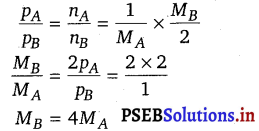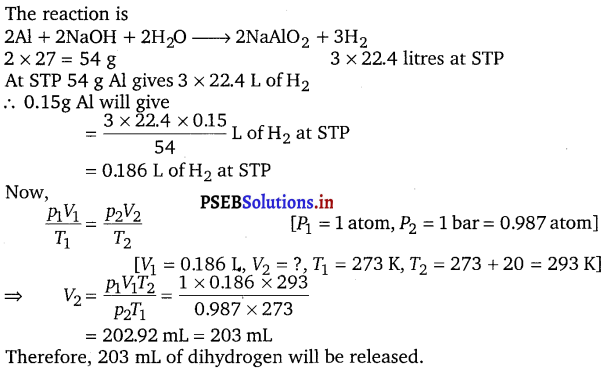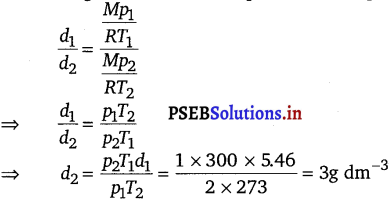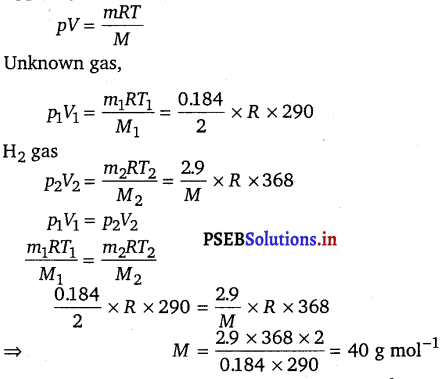Punjab State Board PSEB 11th Class Chemistry Book Solutions Chapter 5 States of Matter Textbook Exercise Questions and Answers.
PSEB Solutions for Class 11 Chemistry Chapter 5 States of Matter
PSEB 11th Class Chemistry Guide States of Matter InText Questions and Answers
Question 1.
What will be the minimum pressure required to compress 500 dm3 of air at 1 bar to 200 dm3 at 30° C?
Answer:
Given,
Initial pressure, P1 =1 bar
Initial volume, V1 = 500 dm3
Final volume, V2 = 200 dm3
Final pressure, P2 = ?
Sipce the temperature remains constant at30°C.
According to Boyle’s law,
P1V1 = P2V2
⇒ P2 = \(\frac{p_{1} V_{1}}{V_{2}}=\frac{1 \times 500}{200}\) bar = 2.5 bar
Therefore, the minimum pressure required is 2.5 bar.
![]()
Question 2.
A vessel of 120 mL capacity contains a certain amount of gas at 35°C and 1.2 bar pressure. The gas is transferred to another vessel of volume 180 mL at 35°C. What would be its pressure?
Answer:
Given,
Initial pressure, P1 =1.2 bar
Initial volume, V1 = 120 mL
Final volume, V2 = 180 mL
Final pressure, P2 = ?
Since the temperature remains constant at 35°C.
According to Boyle’s law,
⇒ P2 = \(\frac{p_{1} V_{1}}{V_{2}}=\frac{1.2 \times 120}{180}\) bar = 0.8 bar
Therefore, the pressure would be 0.8 bar.
Question 3.
Using the equation of state pV = nRT; show that at a given temperature density of a gas is proportional to gas pressure p.
Answer:
The equation of state is given by
pV = nRT

or d = \(\frac{p M}{R T}\)
If T constant, then d ∝ p.
Question 4.
At 0°C, the density of a certain oxide of a gas at 2 bar is same as that of dinitrogen at 5 bar. What is the molecular mass of the oxide?
Answer:
Density (d) of the substance at temperature (T)
d = \(\frac{p M}{R T}\)
When T and d are same and R is constant then
p1M1 = p2M2
Given, P1 = 2 bar
p2 = 5 bar
Molecular mass of nitrogen, M2 = 28g/mol
Now, M1 = \(\frac{M_{2} p_{2}^{2}}{p_{1}}=\frac{28 \times 5}{2}\) = 70 g/mol
Hence, the molecular mass of the oxide is 70 g/ mol.
Question 5.
Pressure of 1 g of an ideal gas A at 27°C is found to be 2 bar. When 2 g of another ideal gas B is introduced in the same flask at same temperature the pressure becomes 3 bar. Find a relationship between their molecular masses.
Answer:
For ideal gas A, the ideal gas equation is given by
pAV – nART …(i)
Where, pA and nA represent the pressure and number of moles of gas A. For ideal gas B, the ideal gas equation is given by
pBV = nBRT …(ii)
Where, pB and nB represent the pressure and number of moles of gas B.
Number of moles of A gas, nA = \(\frac{1}{M_{A}}\) [MA = molar mass of gas A]
Number of moles of B gas, nB = \(\frac{2}{M_{B}}\) [MB = molar mass of gas B]
Pressure of gas A, pA = 2 bar
Total pressure Ptotal = pA + pB = 3 bar
Pressure of gas B, pB = ptotal – pA = 3 – 2 = 1 bar
V, R and T are same for both the gases.
Hence from eqs. (i) and (ii)

![]()
Question 6.
The drain cleaner, Drainex contains small hits of aluminum which react with caustic soda to produce dihydrogen. What volume of dihydrogen at 20°C and one bar will be released when 0.15g of aluminum reacts?
Answer:

Question 7.
What will be the pressure exerted by a mixture of 3.2 g of methane and 4.4g of carbon dioxide contained in a 9 dm3 flask at 27°C?
Answer:
Mass of CH4 = \(\frac{\text { Mass of } \mathrm{CH}_{4}}{\text { Molar mass of } \mathrm{CH}_{4}}\)
[Molar mass of CH4 = 12 + 4 x 1 = 16]
= \(\frac{3.2}{16}\) = 0.2 mol
Mass of CO2 = \(\frac{4.4}{44}\) = 0.1 mol
[Molar mass of CO2 = 12 + 2 x 16 = 44]
Total moles = 0.2 + 0.1 = 0.3 mol
Pressure P = \(\frac{n R T}{V}=\frac{0.3 \times 8.314 \times 300}{9 \times 10^{-3}}\) = 8.314 x 104 Pa
Question 8.
What will be the pressure of the gaseous mixture when o.5L of H2 at 0.8 bar and 2.0 L of dioxygen at 0.7 bar are introduced in a 1L vessel at 27°C?
Answer:
To calculate the partial pressure of H2, Le., pH2
V1 = 0.5L, V2 = 1L, p1 = 0.8 bar, p2 = ?
Temperature remaining constant, applying Boyl&s Law
p1V1=p2V2
0.8 x 0.5= p2 x 1
or P2 = 0.4 bar
To calculate the partial pressure of O2 i.e., PO2
V1 = 2.0L, V2 = 1L, p1 = 0.7 bar, P2 = ?
Applying Boyle’s Law
p1V1 = p2V2
0.7 x 2.0 = 1 x p2
or p2 = 1.4 bar.
If p is final pressure of the gas mixture, then according to Dalton’s Law of partial pressures
p = pH2 + pO2 = (0.4 +1.4)
= 1.8 bar
Question 9.
Density of a gas is found to be 5.46 g/dm3 at 27°C at 2 bar pressure. What will be its density at STP?
Answer:
Given,
d1 = 5.46 g/dm3
p1 = 2 bar
T1 = 27°C = (27 + 273)K = 300 K
P2 = 1 bar
T2 = °C = 273 K
d2 = ?
Density a = \(\frac{M p}{R T}\)
For same gas at different temperatures and pressures

![]()
Question 10.
34.05 ml. of phosphorus vapour weighs 0.0625g at 546°C and 0.1 bar pressure. What is the molar mass of phosphorus?
Answer:
Given,
p= 0.1 bar
V= 34.05 mL = 34.05 x 10-3L
R = 0.083 bar dm3K-1 mol-1
T = 546°C = (546 + 273) K = 819 K
Mass, M = 0.0625 g
Now, pV = nRT
n = \(\frac{p V}{R T}=\frac{0.1 \times 34.05 \times 10^{-3}}{0.083 \times 819}\)= 5.0 x 10-5 mol-1
∴ Molar mass of phosphorus = \(\frac{0.0625}{5.0 \times 10^{-5}}\) = 1250 g mol-1
Hence, the molar mass of phosphorus is = 1250 g mol-1
Question 11.
A student forgot to add the reaction nixture to the round bottomed flask at 27°C but instead he/she placed the flask on the flame. After a lapse of time, he realized his mistake, and using a pyrometer he found the temperature of the flask was 477°C. What fraction of air would have been expelled out?
Answer:
Let the volume of the round bottomed flask = V cm3 at 27°C = 300 K
V1 = V, T1 = (27 + 273)K = 300K, V2 =?,
T2 = 477° C = (477 + 273)K
According to Charles’s law,
\(\frac{V_{1}}{T_{1}}=\frac{V_{2}}{T_{2}}\)
V2 = \(\frac{V_{1} T_{2}}{T_{1}}=\frac{750 \mathrm{~V}}{300}\) = 2.5V
Therefore, volume of air expelled out = 2.5 V – V = 1.5 V
Hence, fraction of air expelled out = \(\frac{1.5 \mathrm{~V}}{2.5 \mathrm{~V}}\) = 0.6
Question 12.
Calculate the temperature of 4.0 mol of a gas occupying 5 dm3 at 3.32 bar. (R = 0.083 bar dm3K-1 mol-1).
Answer:
Given,
n = 4.0 mol, V = 5 dm3, p = 3.32 bar, R = 0.083 bar dm3K-1mol-1
Applying ideal gas equation ‘
pV = nRT
T = \(\frac{p V}{n R}=\frac{3.32 \times 5}{4 \times 0.083}\) = 50K
Hence, the required temperature is 50 K.
Question 13.
Calculate the total number of electrons present in 1.4g of dinitrogen gas.
Answer:
Molar mass of dinitrogen (N2) = 28 g mol-1 Mass
Moles = \(\frac{Mass}{Molar mass}\)
nN2 = \(\frac{1.4}{28}\) = 0.05 mol
1 mol = 6.022 x 1023 molecules
0.05 mol = 0.05 x 6.022 x 1023 molecules
= 0.3011 x 1023 molecules
Now, 1 molecule of N2 contains = 14 electrons.
Therefore, 0.3011 x 1023 molecules will contain = 14 x 0.3011 x 1023
= 4.214 x 1023 electrons
Question 14.
How much time would it take to distribute one Avogadro number of wheat grains, if 1010 grains are distributed each second?
Answer:
Avogadro number, NA = 6.022 x 1023

Hence, the time taken would be 1.909 x 106 years.
Question 15.
Calculate the total pressure in a mixture of 8 g of dioxygen and 4 g of dihydrogen confined in a vessel of 1 dm3 at 27°C.
R 0.083 bar dm3 K-1 mol-1
Answer:
Moles of O2 = \(\frac{\text { Mass }}{\text { Molar weight }}=\frac{8}{32}\) = 0.25 mol
Moles of H2 = \(\frac{4}{2}\) = 2 mol
Therefore, total number of moles in the mixture = 0.25 + 2- 2.25 mol
Given, V = 1 dm3
n = 2.25 mol
R = 0.083 bar dm3K-1mol-1
T = 27°C = 300K
pV= nRT
⇒ Pressure, p = \(\frac{n R T}{V}=\frac{2.25 \times 0.083 \times 300}{1}\) = 56.025 bar.
Hence, the total pressure of the mixture is 56.025 bar.
![]()
Question 16.
Pay load is defined as the difference between the mass of displaced air and the mass of the balloon. Calculate the pay load when a balloon of radius 10m, mass 100kg is filled with helium at 1.66 bar at 27°C.(Density of air = 1.2 kg m-3 and R = 0.083 bar dm3K-1 mol-1)
Answer:
Given,
Radius of the balloon, r = 10m
∴ Volume of the balloon = \(\frac{4}{3} \pi r^{3}=\frac{4}{3} \times \frac{22}{7}\) x 103 = 4190.5 m3(approx)
∴ Mass of displaced air = Vdisplaced air x density of air
= 4190.5 x 1.2 kg = 5028.6 kg
Now, mass of helium (m) filled in balloon
\(m_{\mathrm{He}}=\frac{M p V}{R T}\)
Here, M = 4 x 10-3 kg mol-1
p= 1.66 bar
V = Volume of the balloon = 4190.5 x 103 dm3
R = 0.083 bar dm3K-1mol-1
T = 27°C = 300 K
Then mHe = \(\frac{4 \times 10^{-3} \times 1.66 \times 4190.5 \times 10^{3}}{0.083 \times 300}\) = 1117.5kg(approx)
Now, total mass of the balloon filled with helium
= (100 +1117.5)kg = 1217.5kg
Hence, pay load = mass of displaced air – mass of balloon
= (5028.6 -1217.5) kg = 3811.1 kg
Hence, the pay load of the balloon is 3811.1 kg
Question 17.
Calculate the volume occupied by 8.8g of CO2 at 31.1°C and 1 bar pressure. (R = 0.083 bar LK-1 mol-1).
Answer:
We know that,
pV = nRT m
pV = \(\frac{m}{M} R T\)
V = \(\frac{m R T}{M p}\)
Here, m = 8.8 g
R = 0.083 bar LK-1mol-1
T = 31.1°C = 304.1 K
M = 44 g mol-1
p = 1 bar
Then, volume V = \(\frac{8.8 \times 0.083 \times 304.1}{44 \times 1}\) = 5.048 L
Hence, the volume occupied is 5.048 L.
Question 18.
2.9 g of a gas at 95°C occupied the same volume as 0.184 g of dihydrogen at 17°C, at the same pressure. What is the molar mass of the gas?
Answer:
Applying the ideal gas equation pV = nRT

Hence, the molar mass of the gas is 40 g mol-1 .
Question 19.
A mixture of dihydrogen and dioxygen at one bar pressure contains 20% by weight of dihydrogen. Calculate the partial pressure of dihydrogen.
Answer:
Let the weight of dihydrogen be 20 g and the weight of dioxygen be 80g.
Moles of dihydrogen,
nH2 = 20/2 = 10 mol
Moles of dioxygen,
nO2 = 80/32 = 2.5 mol
Given,
Total pressure of the mixture, ptotal = 1 bar
Then, partial pressure of dihydrogen,
pH2 = \(\frac{n_{\mathrm{H}_{2}}}{n_{\mathrm{H}_{2}}+n_{\mathrm{O}_{2}}} \times p_{\text {total }}=\frac{10}{10+2.5} \times 1\) = 0.8 bar
Hence, the partial pressure of dihydrogen is 0.8 bar.
Question 20.
What would be the SI unit for the quantity pV2 T2 / n?
Answer:
The SI unit of \(\frac{p V^{2} T^{2}}{n}\) is given by
= \(\frac{\left(\mathrm{Nm}^{-2}\right)\left(\mathrm{m}^{3}\right)^{2}(\mathrm{~K})^{2}}{\mathrm{~mol}}\) = Nm4K2mol-1
Question 21.
In terms of Charles’ law explain why -273°C is the lowest possible temperature.
Answer:
According to Charles’ law,
Vt = V0 [1 + \(\frac{t}{273}\) ]
At t = -273° C
Vt = V0 = [1 – \(\frac{273}{273}\) ] = 0
Thus, at -273° C, volume of a gas becomes zero and below this temperature the volume becomes negative, which is meaningless.
![]()
Question 22.
Critical temperature for carbon dioxide and methane are 31.1° C and -81.9°C respectively. Which of these has stronger intermolecular forces and why?
Answer:
Higher is the critical temperature of a gas, easier is its liquefaction. This means that the intermolecular forces of attraction between the molecules of a gas are directly proportional to its critical temperature. Hence, intermolecular forces of attraction are stronger in the case of C02.
Question 23.
Explain the physical significance of van der Waals parameters.
Answer:
Significance of constant ‘a’ : The value of constant ‘a’ is a measure of the magnitude of intermolecular forces between the molecules of the gas. Its units are atm L mol-2 . Larger the value of ‘a’ larger will be the intermolecular forces among the gas molecules.
Significance of constant ‘b’ : The constant ‘b’ is called co-volume or excluded volume per mol of a gas. Its units are litre mol-1.The volume of V is four times the actual volume of the molecules. It is measure of effective size of the gas molecules.
